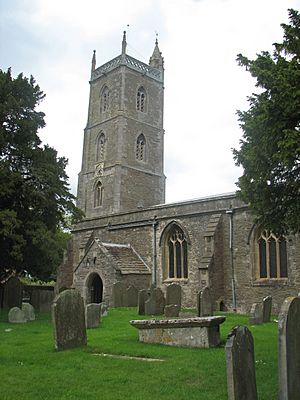Holy Trinity Church, Nailsea facts for kids
Quick facts for kids Holy Trinity Church, Nailsea |
|
|---|---|

Holy Trinity Church, Nailsea
|
|
| Denomination | Church of England |
| Churchmanship | Open Evangelical/Charismatic |
| Website | www.htnailsea.org.uk |
| History | |
| Dedication | Holy Trinity |
| Administration | |
| Parish | Nailsea |
| Deanery | Portishead |
| Archdeaconry | Bath |
| Diocese | Bath and Wells |
| Province | Canterbury |
Holy Trinity Church is an old and beautiful church located in Nailsea, England. It's a special building that has been around since the 1400s! It's so important that it's listed as a Grade I building. This means it's one of the most historic and important buildings in the country. The church has a tall tower with six bells, a peaceful cemetery, and a community centre called "The Trinity Centre" where people can gather.
Contents
History and Design of the Church
The entrance porch of the church was built in 1712. It was later repaired in 1861 by Mr. C.E. Evans, who lived at Nailsea Court. The church tower has four main sections. It features a pointed arch door on the west side. There are also windows with two or three lights on each level.
The tower is supported by strong diagonal buttresses. These are like extra supports built into the walls. At the top, there is a parapet, which is a low wall. You can also see pinnacles, which are small, pointed towers. A spire and a weathervane sit at the very top.
The church was updated in 2003 and 2004. These changes made it more modern and useful for different activities. The old long wooden benches, called pews, were taken out. They were replaced with single, movable chairs. The upper viewing area, or balcony, was also removed. New heating and lighting were put in. A new wooden floor was added, along with a special area for baptisms.
Inside the Church
The Pulpit and Font
The church has an eight-sided stone pulpit. This is where the priest stands to give sermons. It rests on a base against the north wall. It was likely given to the church by the Mede family. They lived at Failand Hill, and their family symbol is on the pulpit. The Mede family was also connected to St Mary Redcliffe church.
The font is a large basin used for baptisms. It has different designs carved into its sides. These include a Tudor rose, which is a famous English symbol. It also shows the five Holy Wounds, which are important in Christian belief. There was even a special pew set aside just for the owners of Nailsea Court.
The Organ
Holy Trinity Church has a pipe organ. It was made by the Sweetland Organ Company. This organ has two keyboards, called manuals.
More to Explore
- List of Grade I listed buildings in North Somerset
- List of towers in Somerset
- List of ecclesiastical parishes in the Diocese of Bath and Wells
Gallery





